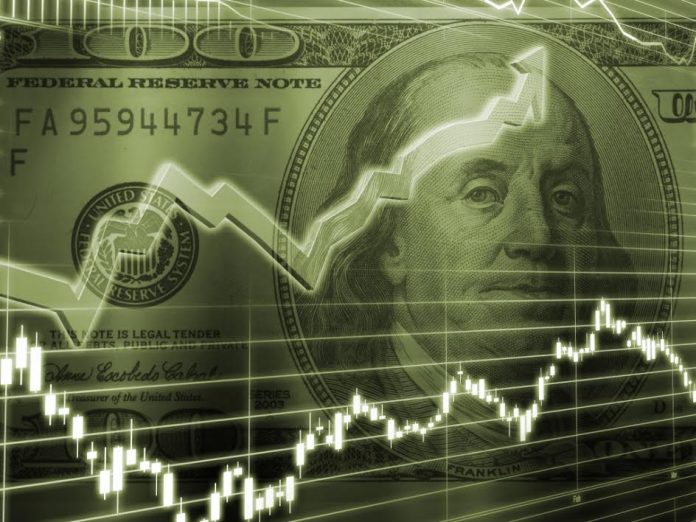LAHORE: The rupee further depreciated against the US dollar falling down to an all-time low of 125 against the greenback in the open market on Wednesday, meanwhile, the dollar weakened by Rs0.33 in the interbank market trading at Rs121.40, after climbing to Rs121.73 earlier.
In the most recent sprint of devaluation, the US dollar hit a record high of Rs121 in interbank trading on Monday. This is the third devaluation by the State Bank of Pakistan (SBP) since December and the hike comes amid mounting economic pressure and speculation of a new bailout programme by the International Monetary Fund (IMF). Meanwhile, increasing imports and a widening current account deficit are often cited as the culprits behind the dwindling currency. The local currency has been under pressure as a result of depleting reserves that now stand at approximately $10 billion.
Beware of Devaluation
Spearhead Research Senior Research Coordinator Farrukh Karamat told Pakistan Today, since December 2017, Pakistan has gone through three bouts of devaluation and rupee has been termed as the worst performing currency of 2018 by Bloomberg. “This then is the legacy of the PML-N government – a weakened currency in the wake of serious macroeconomic imbalances and burgeoning debt. After five years of cosmetic reforms bolstered by incessant borrowing, the country is once again economically threatened and likely to be knocking at IMF’s door, very soon.”
He lamented, “Having artificially maintained the value of the rupee at the Rs105 level for a prolonged period, we are now facing the spectre of drastic devaluation with the projected rupee value likely fall further. Considering Wednesday’s dive to Rs125 in the open market, that in itself is over 19 per cent devaluation within a short span of 7-8 months.”
The ramifications of such a high level of devaluation are manifold, and the people are likely to be burdened with rising costs and higher inflationary pressures, with minimal spillover benefit in terms of higher exports, remittances and investment, Farrukh maintained.
The oft-repeated argument in favour of devaluation is that it allows exports to rise. In the last seven decades with multiple rounds of devaluation, the exports from Pakistan have continued to lag imports and the imaginary benefits of devaluation have never really materialised, Farrukh added.
“Devaluation in isolation is no solution – unless the country can build the required systems, create the infrastructure, enhance competitiveness and reduce import dependence. Unfortunately for Pakistan, with high energy costs, myriad obstacles in conducting business, endemic corruption, low level of competitiveness and low level of human capital development, devaluation is but just one component that by itself is insufficient and ineffective for achieving export enhancement,” he concluded.
Dollar jumps to 11-month high
On Tuesday, dollar rose to an 11-month high and the euro slumped after US President Donald Trump threatened more tariffs on China in an escalating trade dispute investors fear could hurt global growth, international media outlets reported.
The trade war and series of threats have now taken a turn for the worse as Trump on Tuesday threatened to impose a 10 per cent tariff on $200 billion of Chinese goods.
However, Beijing has been swift to issue warnings of serious retaliation this time around with China’s commerce ministry saying Beijing would fight back firmly with “qualitative” and “quantitative” measures if the US publishes additional tariffs.
Up till now the tit-for-tat saga between two of the world’s largest economies has had minimal impact on currencies. But this week currencies including the Australian dollar and Swedish crown have taken a toll of the continued hostility.
The dollar rose against a basket of currencies as traders bet on an escalating trade war forcing inflation up in the US because of costlier imports, raising the prospect of more interest rate rises. Meanwhile, Chinese stocks have sunk almost 4 per cent and the yuan slumped to a five-month low overnight.
Market analysts believe that the trade war will hurt Asian currencies and stocks the most, however, Europe might be next if this escalates.
Safe Havens
A senior market analyst told Pakistan Today, investors have started to move towards currencies traditionally considered safe havens, including gold.
The Japanese yen climbed 0.8 per cent against the dollar to 109.56 yen, its highest level in a week and the Swiss franc rose 0.3 per cent against the dollar to 0.9918 franc.
However, traders are divided whether the row will affect the dollar meaningfully since currency markets in general dislike trade intervention, and previous protectionist efforts by the US government have weakened the dollar. But dollar strengthened half a percent versus a basket of major currencies to hit $95.266 on Tuesday its’ highest since July 2017.
While talking to an international media outlet, Commerzbank Currency Strategist Thu Lan Nguyen said, “If the situation were to escalate the main beneficiary would be the US dollar.”
“And of course a far-reaching trade war would be detrimental for everyone in the end, but mainly the countries whose growth heavily depends on foreign trade,” she said.
Global Devaluation
RTE on Tuesday reported that Yuan slid to a low of 6.4490 to the dollar at one point on Tuesday, its weakest since January 15.
The euro, meanwhile, remained under heavy pressure due to a dispute in Germany’s governing coalition and expectations the European Central Bank will hold interest rates steady up to the summer of 2019.
Chancellor Angela Merkel’s Bavarian allies may defy her by implementing a plan to limit immigration at the German border, which could destabilise her three-month-old coalition.
The single currency Tuesday slumped to a two-week low of $1.1531 after ECB President Mario Draghi called for a patient approach to European monetary policy at a forum in Portugal. The euro had its biggest fall in two years last Thursday after Draghi offered dovish guidance for monetary tightening while outlining details of the end of quantitative easing. Investors and businesses worry that a full-blown trade battle could derail global growth.
Meanwhile, the Australian dollar, a liquid hedge for risk, sank to a one-year low of A$ 0.7380 on the escalating trade dispute and as base metal prices slid. The Canadian dollar, meanwhile, weakened to a one-year low of C$ 1.3237 overnight, before paring some of its losses on Tuesday as investors worried about Canada’s own trade feud with the US.
Moreover, emerging market currencies also came under pressure, with the South African rand shedding 1.9 per cent to touch its seven-month low of 13.9150.























